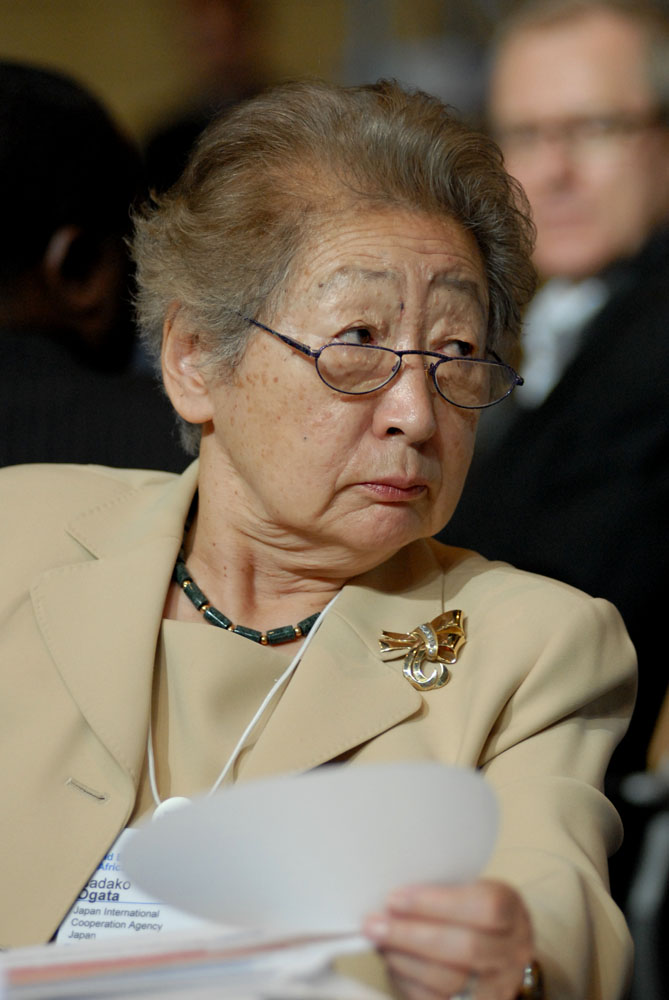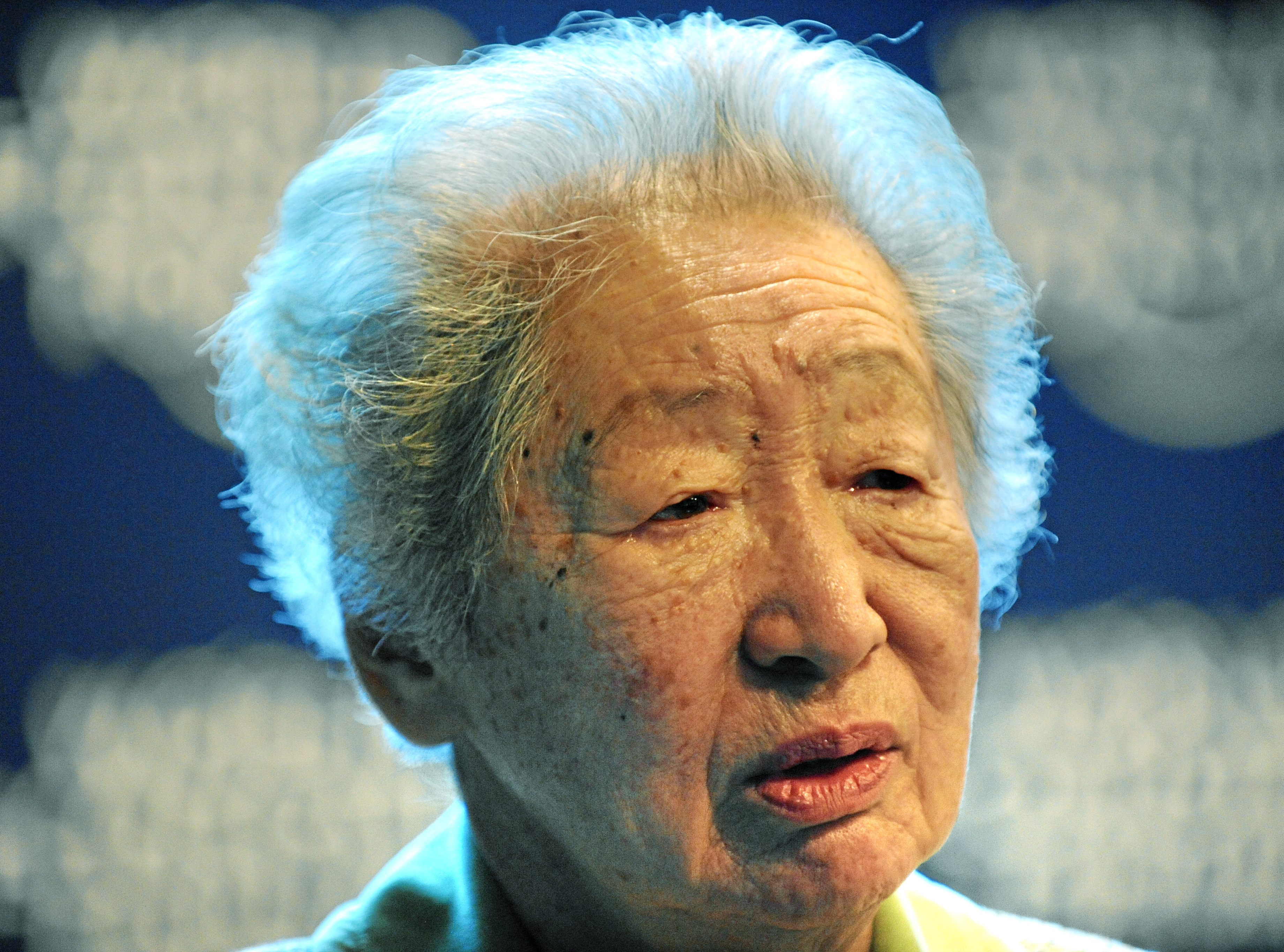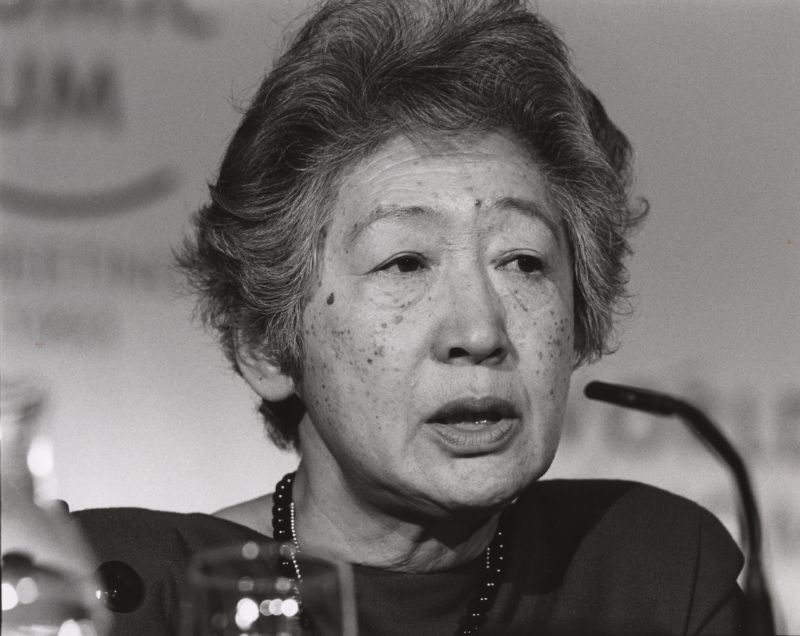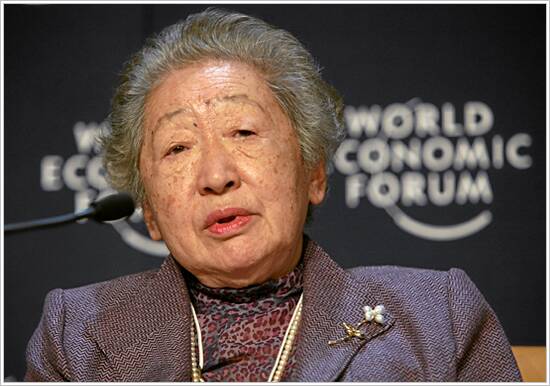1. Overview
Sadako Ogata (緒方貞子Ogata SadakoJapanese), born Sadako Nakamura, was a distinguished Japanese academic, diplomat, author, and administrator known globally for her profound commitment to humanitarianism and human security. She rose to prominence as the first woman to serve as the United Nations High Commissioner for Refugees (UNHCR) from 1991 to 2000, where she spearheaded efforts to protect vulnerable populations amidst some of the world's most severe humanitarian crises. Following her tenure at the UN, she became the President of the Japan International Cooperation Agency (JICA) from 2003 to 2012, transforming it into a leading bilateral aid organization with a strong emphasis on peace-building and human-centered development. Throughout her extensive career, Ogata championed social justice and the empowerment of individuals, advocating for pragmatic, on-the-ground solutions to global challenges and leaving a lasting legacy in international relations and humanitarian aid.
2. Early Life and Education
Sadako Ogata was born Sadako Nakamura on September 16, 1927, in Tokyo, Japan, into a prominent family. Her father, Toyoichi Nakamura, was a career diplomat who later became the Japanese ambassador to Finland in 1943. Her mother was the daughter of Kenkichi Yoshizawa, a former Foreign Minister, and the granddaughter of Inukai Tsuyoshi, who served as the Prime Minister of Japan. Prime Minister Inukai Tsuyoshi was assassinated in the May 15 Incident when Ogata was just four years old, an event that deeply impacted her and marked the end of civilian control over the Japanese military until after World War II.
Due to her father's diplomatic postings, Ogata spent parts of her early childhood living abroad. From ages four to eight, she resided in the United States, attending the Catlin Gabel School in Portland. She then lived in China from ages eight to ten, during the period of Japanese occupation, while her father served as a Japanese consul in Guangzhou and Hong Kong. The family returned to Japan before World War II.
After the war, she graduated from the University of the Sacred Heart in Tokyo with a bachelor's degree in English Literature in 1951. Despite it being uncommon for Japanese women to study abroad at the time, Ogata pursued further education in the United States. She attended Georgetown University's Edmund A. Walsh School of Foreign Service, earning a master's degree in International Relations in 1953. Her motivation for these studies was deeply rooted in her family history; she sought to understand the reasons behind Japan's reckless aggression in the war, which she felt was unchecked after the assassination of her great-grandfather, Prime Minister Inukai Tsuyoshi. She continued her academic pursuits at the University of California, Berkeley, where she was awarded a PhD in Political Science in 1963. Her doctoral dissertation focused on the political dynamics behind the establishment of Manchukuo, a study that analyzed the causes of the Japanese invasion of China. In 1960, she married Shijuro Ogata, a banker, and changed her name from Sadako Nakamura to Sadako Ogata.
3. Academic Career and Writings
Sadako Ogata dedicated a significant portion of her career to academia, teaching and researching international politics. In 1965, she became a Lecturer at International Christian University (ICU) in Tokyo. After 1980, she joined Sophia University in Tokyo as a professor of international politics, later becoming the Dean of the Faculty of Foreign Studies until her appointment as the head of UNHCR in 1991. At Sophia University, she also served as the director of the Institute of International Relations.
Ogata was a pioneer in the field of Model United Nations (MUN) in Japan, actively involved in its foundation and serving as an advisor to the Model United Nations Executive Committee, which later became the Japan Model United Nations (JMUN). Her guidance influenced many students who went on to become distinguished academics in international relations, such as Ken Nobayashi and Masashi Naya.
Her academic research primarily focused on international politics, with a particular emphasis on East Asian relations and humanitarian issues. Her doctoral dissertation, "Defiance in Manchuria: the Making of Japanese Foreign Policy, 1931-1932," published in 1964, provided an in-depth analysis of the causes of Japan's invasion of China. This work demonstrated her early and consistent commitment to understanding the roots of conflict.
Throughout her career, Ogata authored and co-authored several influential books and papers that articulated her views on refugees, humanitarian crises, and international cooperation. Her notable works include:
- Defiance in Manchuria: the Making of Japanese Foreign Policy, 1931-1932 (Greenwood Press, 1964; reissued in Japan as 満州事変--政策の形成過程Japanese by Iwanami Gendaibunko, 2011)
- Normalization with China: A Comparative Study of U.S. and Japanese Processes (Institute of East Asian Studies, University of California, 1988; translated into Japanese as 戦後日中・米中関係Japanese by Yoshihide Soeya and published by University of Tokyo Press, 1992)
- 難民つくらぬ世界へJapanese (Towards a World Without Refugees) (Iwanami Shoten, 1996)
- 私の仕事--国連難民高等弁務官の十年と平和の構築Japanese (My Work: Ten Years as UN High Commissioner for Refugees and Building Peace) (Soshisha, 2002)
- The Turbulent Decade: Confronting the Refugee Crises of the 1990s (W.W. Norton, 2005; translated into Japanese as 紛争と難民--緒方貞子の回想Japanese by Shueisha, 2006)
- 共に生きるということ--be humaneJapanese (Living Together: Be Humane) (PHP Kenkyusho, 2013)
She also contributed to and edited several collaborative works, including At the Global Crossroads: the Sylvia Ostry Foundation Lectures (McGill-Queen's University Press, 2003) and 聞き書 緒方貞子回顧録Japanese (Oral History: Sadako Ogata's Memoirs) (Iwanami Shoten, 2015), which compiled extensive interviews with her. Her writings consistently highlighted her emphasis on human security, the critical need for international cooperation, and a pragmatic, field-oriented approach to humanitarian challenges.
4. Career in International Service
Sadako Ogata had a distinguished career in international service, spanning several decades and leaving an indelible mark on global humanitarian efforts and international cooperation. Her leadership was characterized by a strong commitment to addressing the root causes of human suffering and promoting human security.
4.1. Early United Nations Roles
Ogata's involvement with the United Nations began in 1968 when she was appointed to Japan's UN mission. This appointment came at the recommendation of Fusae Ichikawa, a pioneering activist for women's suffrage and a respected member of the House of Councillors, who held a high regard for Ogata's character and abilities. Ogata subsequently represented Japan at several sessions of the United Nations General Assembly in 1970.
Her diplomatic roles continued to expand within the UN framework. From 1978 to 1979, she served as Envoy Extraordinary and Minister Plenipotentiary for the permanent mission of Japan to the UN. During this period, she also held the significant position of Chair of the UNICEF Executive Board, demonstrating her early engagement with issues concerning vulnerable populations, particularly children. In 1979, she became a special advisor to the Ministry of Foreign Affairs and led a Japanese fact-finding mission for Cambodian refugees, further solidifying her expertise in humanitarian affairs.
4.1.1. United Nations High Commissioner for Refugees (UNHCR)
In 1990, Sadako Ogata was appointed as the head of the United Nations High Commissioner for Refugees (UNHCR), making her the first woman to hold this prestigious and challenging position. She left her professorship at Sophia University to take on this new role. Her initial term was expected to be only three years, completing the remainder of her predecessor's term. However, due to her exceptional leadership and the escalating global refugee crises, she was re-elected twice, serving for over a decade until 2001.

During her tenure, Ogata confronted some of the most complex and devastating humanitarian emergencies of the late 20th century. She implemented effective strategies that provided relief and protection to countless refugees, including Kurdish refugees displaced after the Gulf War, millions affected by the Yugoslav Wars, victims of the Rwandan genocide, and Afghan refugees suffering from the consequences of the Cold War. A pivotal moment in her leadership was the crisis involving Kurdish refugees on the border between Turkey and Iraq. In response, Ogata boldly expanded the traditional mandate of UNHCR to include the protection of internally displaced persons (IDPs), recognizing that many in need of protection did not cross international borders.
Ogata was known for her pragmatic and hands-on "field-oriented" approach to humanitarian operations. She was willing to deploy military forces in support of humanitarian efforts when necessary, as seen in the siege of Sarajevo during the Bosnian War, where UNHCR coordinated airlift operations with European air forces to deliver aid. This innovative and decisive leadership style significantly enhanced the effectiveness of UNHCR's responses. Under her guidance, the UNHCR's budget and staff more than doubled, reflecting the increasing scale and complexity of its operations. Her formidable negotiating skills, combined with her small stature, earned her the affectionate nickname "diminutive giant." After leaving UNHCR in 2001, she continued her advocacy for human security as co-chairperson of the UN Human Security Commission.
4.1.2. Japan International Cooperation Agency (JICA)
After her distinguished service at UNHCR, Sadako Ogata returned to Japan and was appointed President of the Japan International Cooperation Agency (JICA) on October 1, 2003. It was reported that young JICA officials had strongly expressed their desire for her leadership even before her formal appointment, recognizing her vast experience and vision.

Ogata led JICA with a strong emphasis on human security and a "field-oriented" approach, mirroring her philosophy at UNHCR. She prioritized development cooperation that directly benefited individuals and communities, rather than solely focusing on state-centric aid. Under her leadership, JICA significantly expanded its peace-building projects, particularly in conflict-affected regions such as Afghanistan and Mindanao in the Philippines. She integrated loan assistance into JICA's operations, leading to a significant increase in its scale and impact. By 2008, JICA had grown to become the world's largest bilateral aid organization, a testament to her transformative leadership. She served as JICA President for more than two terms, totaling over eight years, before retiring in April 2012.
4.1.3. Refugee Education Trust (RET International)
In December 2000, coinciding with the end of her second term at UNHCR and the agency's 50th anniversary, Sadako Ogata announced the launch of RET International in Geneva, Switzerland. Her vision for RET (originally an acronym for "Refugee Education Trust") was to address a massive gap she had observed during her tenure as High Commissioner: the critical lack of secondary education and vocational training opportunities for refugee youth.
Ogata firmly believed that if adolescents and young people in refugee situations were not provided with opportunities, they would become highly vulnerable to exploitation, including involvement in illegal activities, gangs, underage labor, drug trafficking, sexual abuse, sex trafficking, and violence. RET International was founded to mitigate these risks by equipping refugee youth with essential skills, fostering their resilience, and enabling them to become self-reliant. Initially, RET focused exclusively on providing education within refugee camps, using it as a tool for protection and empowerment. As global refugee migration patterns evolved and new crises emerged, the organization adapted its methods, demonstrating that its approach could also be effectively applied to young people in fragile environments beyond traditional camps. As of 2025, RET International continues to be headquartered in Geneva and operates in 15 countries worldwide, collaborating with various UN agencies, governments, and private foundations to provide opportunities to vulnerable communities.
4.1.4. Other Public Service
Beyond her key roles at UNHCR and JICA, Sadako Ogata held several other significant public service positions. In 2001, in the aftermath of the September 11 attacks, she was appointed as the Special Representative of the Prime Minister of Japan for Reconstruction Assistance to Afghanistan. This role underscored her continued engagement with complex post-conflict recovery efforts.
In early 2002, during a period of political reshuffling, the Junichiro Koizumi government approached Ogata as a potential candidate to replace Makiko Tanaka as the Japanese foreign minister. However, Ogata declined the offer. While she did not publicly elaborate on her refusal, Kuniko Inoguchi (a prominent Japanese political scientist and former Minister of State for Gender Equality) suggested that Ogata "would hate to be used as a token or a figurehead because she has fought all her life for the condition of women, and she wouldn't help someone who would try to use her for their political purposes." Additionally, reports later indicated that her refusal was also influenced by her husband Shijuro Ogata's deteriorating health at the time.
Ogata was also a member of The Advisory Council on the Imperial House Law, which was established on November 27, 2004, as a private advisory organ to then-Prime Minister Junichiro Koizumi within the Cabinet Office. The council met 17 times from January to November 2005 to deliberate on the Japanese succession controversy and the Imperial Household Act. On November 24, 2005, the council's recommendations included supporting the right of female members to ascend to the throne, extending primogeniture to female members of the imperial household, and allowing for female-line succession. Notably, both Ogata and Empress Michiko shared the University of the Sacred Heart as their alma mater.
On April 17, 2012, a "Reception for Respecting Mrs. Sadako Ogata's Contributions to Our Country and the International Community" was held in Tokyo, hosted by then-Foreign Minister Kōichirō Genba. Prime Minister Yoshihiko Noda delivered a speech, remarking that the offers of assistance to Japan from over 160 countries and more than 40 international organizations following the 2011 Tōhoku earthquake and tsunami were "NOT irrelevant to Mrs. Sadako Ogata's achievements," implying her global humanitarian work fostered goodwill towards Japan. Ogata was also involved with the Sergio Vieira de Mello Foundation, further demonstrating her dedication to international peace and human rights.


5. Philosophy and Thought
Sadako Ogata's career was guided by a deeply ingrained philosophy centered on human dignity, resilience, and the critical importance of a pragmatic, on-the-ground approach to global challenges. Her core principles shaped her responses to humanitarian crises and her vision for international development.
5.1. Key Influences
Ogata's worldview and humanitarian philosophy were profoundly shaped by formative experiences and intellectual influences. Her family background, particularly her lineage to Prime Minister Inukai Tsuyoshi, was a significant factor. The assassination of her great-grandfather during the May 15 Incident due to his opposition to Japanese militarism deeply affected her. This event ignited her academic pursuit to understand the mechanisms of international conflict and the reasons for Japan's aggressive wartime policies, which she explored in her doctoral dissertation on the Manchukuo incident. This early exposure to the devastating consequences of political extremism and unchecked military power instilled in her a lifelong commitment to peace and the protection of innocent lives.
Her academic studies in international relations and political science at Georgetown University and the University of California, Berkeley provided her with a robust analytical framework to understand global dynamics. Mentors like Robert Scalapino, under whom she studied Asian politics and international relations at Berkeley, further honed her critical thinking and shaped her perspectives on international cooperation. Growing up in a diplomat's family also gave her early exposure to diverse cultures and international affairs, fostering a global outlook and a nuanced understanding of cross-cultural communication. Her Catholic faith also underpinned her compassionate approach to humanity.
5.2. Core Tenets
At the heart of Ogata's philosophy was her unwavering advocacy for human security. This concept, which she actively championed, posits that the safety and well-being of individuals should be at the forefront of national and international policy, extending beyond traditional state-centric notions of security. She believed that true security is achieved when people are protected from threats such as violence, disease, poverty, and environmental degradation, and are empowered to live with dignity.
A central tenet of her work was the transformative power of education for vulnerable populations, particularly refugee youth. She recognized that providing secondary education and vocational training could act as a crucial protective measure, preventing young people from falling prey to illegal activities, exploitation, and violence, while simultaneously equipping them with the skills to become self-reliant. This conviction led her to establish RET International, a testament to her belief in education as a tool for empowerment and resilience.
Ogata was renowned for her pragmatic, "on-the-ground" approach to humanitarian work. She was not content with policymaking from distant offices; instead, she insisted on being present in conflict zones and refugee camps, directly engaging with affected communities. This hands-on method allowed her to grasp the realities of complex emergencies and formulate realistic, effective solutions. Her willingness to deploy military assets for humanitarian logistics during the Bosnian War, for instance, underscored her practical resolve to overcome obstacles in delivering aid and protection. She believed in empowering individuals and local communities, fostering self-reliance rather than perpetual dependence on aid. Her work was characterized by compassion, a deep respect for human rights, and an unwavering belief in the necessity of international cooperation to address shared global challenges.
6. Personal Life
Sadako Ogata's private life, while often overshadowed by her public service, provided the foundation for her extensive career. She was known to be a Christian and a follower of the Catholic Church.
6.1. Marriage and Family
In 1960, Sadako Nakamura married Shijuro Ogata (1927-2014), a distinguished banker who had a long career at the Bank of Japan, eventually becoming its executive director. Shijuro was the third son of Taketora Ogata, a prominent Japanese politician who served as Vice President of the Liberal Party and Deputy Prime Minister in the Yoshida cabinet. Upon her marriage, she adopted her husband's surname, becoming Sadako Ogata.
Together, Sadako and Shijuro Ogata had two children: a son, Atsushi Ogata, who became a film director, and a daughter. Her family lineage on her mother's side connected her to Inukai Tsuyoshi, who was her great-grandfather, and his son, Tsuyoshi Inukai, was her great-uncle. Her maternal grandfather was Kenkichi Yoshizawa, a diplomat who served as Foreign Minister. On her husband's side, she was connected to the notable Ogata family. Her indirect relatives included Michiko Inukai, a critic, and Yasuhiko Inukai, a former Kyodo News president, both cousins of her mother, and Kazu Ando, an essayist. Other connections included Sadao Iguchi, a diplomat who served as Vice Foreign Minister and Japanese Ambassador to the United States (her uncle by marriage), and Yutaka Kawashima, a diplomat who served as Vice Foreign Minister and Grand Chamberlain (her cousin).
7. Death
Sadako Ogata died on October 22, 2019, at the age of 92. Her passing marked the end of a life dedicated to humanitarian causes and international diplomacy.
8. Recognition and Honors
Sadako Ogata received numerous prestigious international and national awards, decorations, and honorary degrees throughout her career, acknowledging her profound impact on global affairs and humanitarian work.
- 1993: Golden Doves for Peace (Italy)
- 1994: Prize For Freedom by Liberal International
- 1994: Freedom from Want Award (Four Freedoms Award)
- 1995: Liberty Medal from the National Constitution Center (Philadelphia)
- 1995: Member of the American Philosophical Society
- 1996: Félix Houphouët-Boigny Peace Prize by UNESCO
- 1997: Ramon Magsaysay Award (Peace and International Understanding)
- 1999: Asahi Prize Special Award
- 2000: Seoul Peace Prize
- 2000: Founding of the Refugee Education Trust (RET)
- 2001: Person of Cultural Merit (Japan)
- 2001: Indira Gandhi Prize
- 2001: Commander's Cross of the Order of Merit of the Federal Republic of Germany
- 2001: Commander of the Légion d'honneur (France)
- 2001: Knight Grand Cross of the Order of Merit of the Italian Republic
- 2001: Commander First Class of the Order of the Polar Star (Sweden)
- 2001: Order of Friendship (Russia)
- 2002: J. William Fulbright Prize for International Understanding
- 2002: Honorary Doctor of Human Letters from Brown University
- 2002: Eleanor Roosevelt Valkill Medal from the Eleanor Roosevelt Center
- 2003: Order of Culture (Japan)
- 2004: Honorary Citizen of Tokyo
- 2005: World Citizenship Award from the World Association of Girl Guides and Girl Scouts
- 2006: Grand Officer (Maringal na Pinuno) of the Order of Lakandula (Philippines)
- 2008: Grand Officer of the Order of Orange-Nassau (Netherlands)
- 2009: Goto Shinpei Award
- 2011: Honorary Dame Commander of the Order of St Michael and St George (DCMG) (United Kingdom)
- 2011: Medal of the Friendship of Nations (Danaker Medal) (Kyrgyzstan)
- 2012: Global Citizen Awards (Atlantic Council)
- 2013: Band of the Order of the Aztec Eagle (Mexico)
- 2013: Grand Cross of the Order of Sikatuna, Rank of Datu (Philippines)
- 2017: Humanitarian Medal Mother Teresa (Kosovo)
- Posthumous: Junior Third Rank (従三位JusanmiJapanese) (Japan)
9. Legacy and Impact
Sadako Ogata's legacy is immense and multifaceted, profoundly influencing international refugee policy, the concept of human security, and inspiring women in leadership and humanitarian service worldwide. Her tenure as United Nations High Commissioner for Refugees (UNHCR) marked a transformative period for the organization. She redefined refugee protection by expanding its mandate to include internally displaced persons (IDPs), acknowledging the evolving nature of conflicts and forced migration. Her pragmatic, "on-the-ground" approach and willingness to engage with complex political and military dimensions of humanitarian crises set a new standard for effective intervention. She demonstrated that humanitarian aid could not be divorced from political solutions and that decisive leadership was crucial in saving lives and alleviating suffering in volatile environments.
As President of the Japan International Cooperation Agency (JICA), Ogata cemented her vision of human security within the realm of international development. She championed a human-centered approach to aid, focusing on empowering individuals and communities through peace-building and development projects. Her leadership transformed JICA into one of the world's largest and most influential bilateral aid organizations, showcasing how development assistance could contribute to stability and long-term well-being in vulnerable regions.
Ogata's foresight in establishing RET International to provide secondary education and vocational training for refugee youth remains a critical contribution to humanitarian aid. This initiative addressed a significant gap in traditional relief efforts, recognizing that education is fundamental not only for individual empowerment but also for preventing exploitation and fostering resilience among displaced populations.
Beyond her institutional roles, Ogata served as a powerful role model for women seeking careers in international diplomacy and humanitarian work. Her success in breaking barriers as the first female UNHCR head, combined with her intellectual rigor and compassionate leadership, inspired countless individuals globally. Her lifelong dedication to social justice, human rights, and the protection of the most vulnerable populations leaves an enduring impact on how the international community addresses humanitarian challenges and strives for a more secure and equitable world.
10. Family Tree
Sadako Ogata's family connections trace back to several prominent figures in Japanese history and politics.
- Great-Grandfather:** Inukai Tsuyoshi, the 29th Prime Minister of Japan, who was assassinated in 1932.
- Grandfather:** Kenkichi Yoshizawa, a diplomat and Foreign Minister in Inukai's cabinet.
- Father:** Toyoichi Nakamura, a career diplomat who served as Japanese ambassador to Finland.
- Mother:** Tsuneko Nakamura, daughter of Kenkichi Yoshizawa and Tsuyoshi Inukai's daughter, Misao.
- Husband:** Shijuro Ogata, a banker and executive director of the Bank of Japan, and son of Taketora Ogata.
- Father-in-law:** Taketora Ogata, a prominent politician and former Deputy Prime Minister.
- Son:** Atsushi Ogata, a film director.
- Great-Uncle:** Tsuyoshi Inukai, son of Inukai Tsuyoshi.
- Cousins (through her mother's lineage to Inukai Tsuyoshi's son, Tsuyoshi Inukai):**
- Michiko Inukai, a critic.
- Yasuhiko Inukai, former president of Kyodo News.
- Kazu Ando, an essayist.
- Uncle by Marriage:** Sadao Iguchi, a diplomat who served as Vice Foreign Minister and Japanese Ambassador to the United States.
- Cousin:** Yutaka Kawashima, a diplomat who served as Vice Foreign Minister and Grand Chamberlain.
- Cousin:** Yoko Sasanami (née Kawashima), a professor at Keio University and pioneer Japanese female UN official.
11. Notable Quotes
- "If we ignore the plight of the refugees or the burden of the countries which have received them, I fear we will pay a heavy toll in renewed violence. Conditions must be created urgently to allow the refugees to go back and live in peace and tolerance in their own country." - Liberty Medal acceptance speech, July 4, 1995.